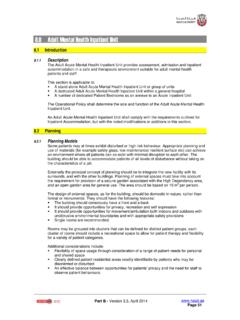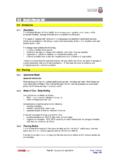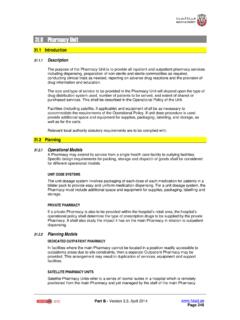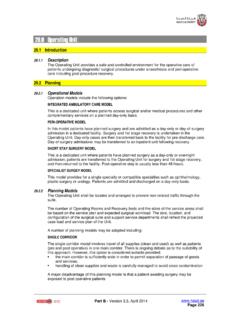Transcription of 22.0 IVF Unit (Fertilisation Centres) - healthdesign.com.au
1 Part B - Version , April 2014 Page 174 ivf unit ( fertilisation Centres) Introduction Description The ivf unit will provide facilities for In vitro fertilisation (IVF) procedures. IVF is one of several Assisted Reproductive Techniques (ART) used to help infertile couples to conceive a child. The procedure involves removal of eggs (mature Oocyte or Ovum) from the woman's ovary. Ova are then fertilised with sperm in a laboratory procedure (in vitro ). If fertilisation occurs, a fertilised ovum, after undergoing several cell divisions, is transferred to the mother for normal development in the uterus, or frozen for later implantation. The IVF laboratory may use Intracytoplasmic Sperm Injection (ICSI) in the process of IVF.
2 Services provided by the ivf unit include: Patient consultation and interview on an outpatient basis Pre treatment assessment Blood collection Semen collection Artificial insemination Ovarian stimulation therapy Ultrasound examination Oocyte (egg) collection Embryo culture In vitro / ICSI fertilisation Cryopreservation Embryo transfer Recovery Licensing Of unit IVF Units ( fertilisation Centres) in the UAE require licensing according to the Cabinet Decision No 36 of 2009 Issuing the Implementing Regulation of Federal Law No (11)
3 Of 2008 Concerning the Licensing of fertilisation in the State. All IVF Units are to comply with the requirements stated in the Cabinet Decision document. Planning Planning Models The ivf unit may be developed as: a stand-alone unit a dedicated unit within a general hospital Functional Areas The ivf unit may consist of a number of Functional Zones: ENTRY/ CONSULT ZONE: Entry/ Reception and waiting areas Administration/ Records Interview Room/s Consult/ Examination/ Treatment Room/s Ultrasound room/s Collection Room/s with Ensuite shower and Toilet Part B - Version , April 2014 Page 175 Public Toilets PATIENT PROCEDURAL ZONE.
4 Operating Room/s for oocyte (egg) collection and re-implantation Recovery areas Change areas and toilets for staff and patients LABORATORY ZONE: Laboratories (Embryology, IVF, ICSI, Andrology, Genetics) Cryopreservation facilities Gas Bottle Store STAFF AND SUPPORT ZONE: Clean-up and Disposal room Store rooms and Sterile store Offices, meeting rooms, staff room Sterilising area: if the ivf unit is a stand-alone building, dedicated sterilising facilities will be required ENTRY/ RECEPTION The Entry and Reception provides the first point of contact for clients. Waiting areas should be calm, comforting and relaxing.
5 They should be divided for gender separation. COLLECTION ROOM(S) Collection room(s) should be discreet and private, enclosed rooms for collection of sperm samples. OPERATING ROOM(S) Operating room(s) will include equipment and facilities for egg collection and embryo transfer, under local anaesthetic. Operating rooms will require adjacent Patient and Staff Change Rooms, scrub sink and patient toilet facilities. LABORATORIES Strict protocols for handling and labelling patient specimens in all laboratory areas are required. Laboratory areas should be zoned in a restricted staff access only area. EMBRYOLOGY/ IVF/ ICSI LABORATORY The embryology laboratory provides facilities for the handling, preparation, culture and storage of human gametes (sperm and oocytes ).
6 Due to the sensitive nature of its functions, the embryology laboratory should be located in a secure and sterile area away from the outpatient/ clinic facilities but in close proximity to the procedure room where the oocytes (eggs) are collected. The laboratory is responsible for identifying oocytes in ovarian fluid, culturing these eggs with the partner's sperm, and embryo examination prior to embryo implantation into the patient. The ICSI (Intracytoplasmic Sperm Injection) laboratory involves the process of injecting a single sperm into the nucleus of the egg using a microscopic needle without affecting the viability of the egg. The zygote (fertilised egg) is then monitored until it starts to divide forming a small cluster of cells known as the blastocyst (in approximately 5 days in the lab) which is then reimplanted to form an embryo.
7 ANDROLOGY LABORATORY The Andrology laboratory performs the evaluation, testing, preparation and storage of sperm Part B - Version , April 2014 Page 176 specimens. Diagnostic procedures include: semen analysis determine sperm count, motility, viability and morphology, preparation of sperm for fertilization and Intrauterine Insemination (IUI) and thawing of frozen specimens. GENETICS LABORATORY The Genetics Laboratory undertakes cytogenetics studies of the embryo cells, particularly the nucleus which contains the chromosomes that carry genes and their DNA to determine the status of the embryo after IVF and before re-implantation, also referred to as Pre-implantation Genetic Diagnosis (PGD).
8 This process can also identify and diagnose abnormalities and genetic diseases that may accompany the pregnancy by the use of sophisticated techniques such as Fluorescence In-Situ Hybridization (FISH) or Polymerase Chain Reaction (PCR). CRYOPRESERVATION FACILITIES Facilities for cryopreservation will include a separate room for storage of reproductive cells (gametes, zygotes and embryos) in liquid nitrogen storage tanks. Strict protocols on the method of storage and specimen labelling are required for this process (refer to regulations on the licensing of fertilisation Centres in UAE). Functional Relationships EXTERNAL The ivf unit may have a close working relationship with Pathology Laboratories Pharmacy Medical Imaging The ivf unit should be ideally located on the Ground floor.
9 If located on an upper floor, there must be a stretcher carrying lift available. INTERNAL Within the ivf unit the following relationships are significant: Laboratory areas should be located with a direct adjacent relationship to the Operating rooms for egg collection and re-implantation Laboratories should be located in a separate zone away from the outpatient/ consult area and secured. Sperm Collection rooms have a close functional relationship with the Andrology Laboratory; specimens require rapid transfer to the laboratory to avoid deterioration. Office areas should be separate from the treatment and laboratory zone Design General The design of the unit should create a pleasant, reassuring atmosphere for patients whilst retaining the necessary functional requirements associated with clinical spaces and laboratories.
10 Ideally, waiting areas should be divided into several small Family Waiting zones or nooks to allow partners or close relatives to wait in relative privacy. In addition to the above, in the UAE, separate zones for male and female patients should be provided. Consideration may be given to a private and discreet entry area for patients, away from general public view. Part B - Version , April 2014 Page 177 Environmental Considerations NATURAL LIGHT Natural light is highly desirable where achievable, particularly for laboratory areas where staff will spend a majority of their time. PRIVACY Privacy is essential for confidential conversations and interviews and will minimise stress and discomfort for patients.









